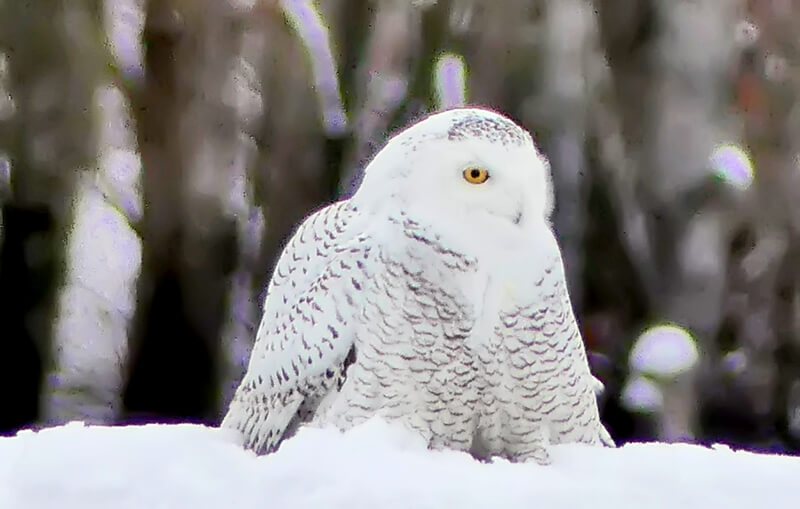Surviving winter (without a wood stove)
If the world seems quiet beneath its blanket of white, think again. Hidden in plain sight, or under the snow and ice, there’s plenty of winter activity. Here’s a window into some critters’ cold-weather strategies.
With little temperature flexibility, warm-blooded mammals find warmth where they can—in caves, stone walls or your compost heap. Dormant animals alternately sleep and wake, venturing out on warm days in search of food but otherwise slumbering. Vermont’s dormant population includes black bears, raccoons, skunks and chipmunks.

Many mammals do what humans do—accumulate an extra layer of fat. Fur coats thicken. Deer grow hollow hairs to retain additional body heat. Snowshoe hares and weasels turn white for camouflage against the snow, the hares growing extra fur on their feet that serves as snowshoes.
True hibernators lower their body temperature and heartrate. In Vermont, the jumping mouse, woodchucks, bats, the familiar red eft, and some turtles, frogs and snakes hibernate. Some species of frog have enough glycerol in their blood to survive thawing and freezing through several cycles each winter.
The only marsupial in North America, the Virginia opossum or “possum,” has moved north into Vermont with climate change. Poorly adapted to our winters with a thin coat and hairless ears and tail, the possum gets frost-bitten frequently, which ages them prematurely. They generally do not live to be two years old in Vermont, whereas they can live much longer in warmer regions. Given their poor adaptations for winter and high mortality rate, how do any possums survive here? They put on a layer of fat, providing a little extra insulation, and remain in their dens on exceptionally cold days.
In warmer climes possums can have two to three litters each year, but in Vermont they generally have just one. A mere 13 days from breeding, the honeybee-sized young crawl unaided to the mother’s pouch where they will nurse for the next 50 to 70 days. At about three months, they are fully weaned. The Vermont Center for Ecostudies January Field Guide says that the defense mechanism of “playing possum,” or playing dead, is a last resort if hissing and fluffing out its coat does not frighten predators. The possum becomes limp and motionless, lying on its side with mouth open and tongue hanging out. Heartbeat and breathing slow to almost undetectable; it sometimes releases a putrid-smelling green fluid from glands on its rear.
Take note and leave possums alone to eat the ticks in your yard! Possums consume up to 95% of the ticks in their path and can eat more than 5,000 each season. I’m wondering how to make our yard more attractive to them.
What becomes of pond dwellers? Unable to regulate their body temperatures, cold-blooded animals slow their activities as their metabolism shuts down. They generally survive if they are not encased in solid ice. Beneath the icy surface in water that never freezes, these creatures are insulated from temperatures that may plunge well below zero. Some turtles sink to the muddy bottom of ponds and rivers where they will remain until spring. Amphibians, such as frogs and toads, may sleep through winter on land, beneath logs and leaf litter, or lay eggs that will hatch in the spring whether or not the parent survives.
Snowy owls, the adults mostly white, hunt by day and often perch on posts or fences beside an open field. Quick and nimble, they pounce on small mammals and can catch birds in flight. Snowy owls breed in the tundra and some years, if their traditional food sources are in short supply farther north, they winter in Vermont. Recently a snowy owl has been spotted wintering in Shelburne.
January is courtship time for some of our non-migratory owls, including Great Horned. You may hear them during our long nights, their haunting hoo-hoo-hoos echoing back and forth. Among the earliest nesters in Vermont, Great Horned Owls use abandoned nests of eagles, hawks, osprey or squirrels and cavities or caves that are 30 to 70 feet above the ground. Females lay one to four eggs that hatch after 30 to 37 days. In February, listen for the courtship of Barred Owls, of which there are many in Charlotte: “who-cooks-for-you.”
Meanwhile, humans keep warm by turning up the heat or exercising to get blood flowing in the outdoors. Whatever your strategy, take heart. Spring will come one day.

